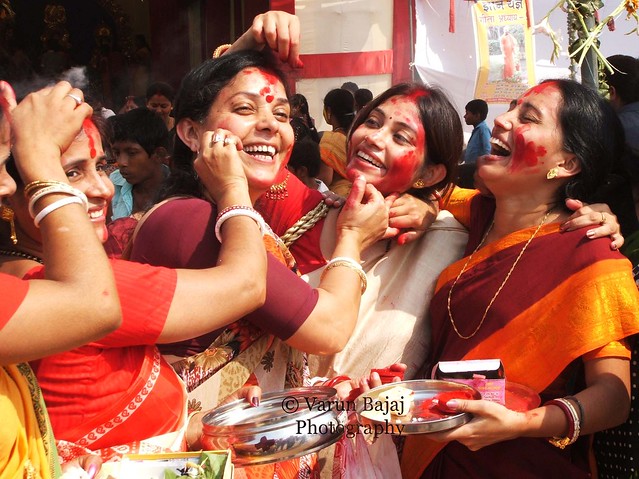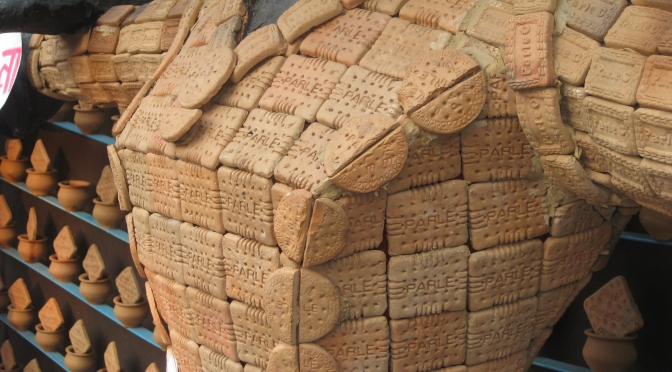It was Durga Puja. The air was full of the non-stop beat of pujo’r dhaak (drum), music, microphone announcements, children’s elocution recitations, honks of a thousand cars, autorickshaws, rickshaws, voices of screaming kids and parents, lost and found announcements, children bursting crackers in their toy guns (“caps”) that went off with loud booms, pujo mantras (incantations) and loud ghanta’s (pujo bells) for the last five days.
Now there is all silence.


The roads were full of streams of crowds from all walks of life, mostly youngsters and huge groups from distant parts of the city and outside suburbs walking along the roads inside bamboo barricades, dressed in their best new finery (some of which had zari borders that glowed in the dark). They had to stop at police ropes at intervals, taking tiny detours around sleeping dogs who seemed pretty nonchalant, considering the crowds who were desperate to see the pujo pandals, either patiently waiting or getting into skirmishes with police and volunteers, lifting their hands as far above the million heads as possible to take pictures, posting on social media in real time, desperate in their desire to savour the moment.
And this morning, it’s all empty. At least as empty as Calcutta can get.

Only the bamboo barricades stand along the empty pavements now while regular Sunday traffic moves along. The police barricades are gone. It is strange to be able to actually see the coconut fibre ropes tying together the bamboo, something which was impossible to discern when the great crowds moved along. The temporary arches stand empty while the advertisements and cutouts remind one of a party that is over. As you stand on the verandah, you overhear people talking: “Only last week, Durga Puja was just about to come. . ..”


The tea stalls are empty. Many of the makeshift food stalls I wrote so much about stand abandoned for now on the sides of the road, the vendors and assistants probably exhausted after four days of non-stop exertion day and night. The henna and henna tattoo people dotting the sidewalks are gone. The trash bins are full of disposable plates and in many places, the sidewalks are covered with paper discarded from chicken, muton, egg kathi rolls. The huge carousels and Dragon Trains (toy trains) still stand and will probably keep running for a few more days but the bald spots in the grass (because of the many feet that have gone over them) are more visible now in the empty fields.

The idols have already been taken down (or are being taken down) to be immersed in the river now that Durga has returned home. Those afraid of traffic jams because of the processions accompanying bishorjon (the rituals and act of immersion of the idols) have been avoiding the roads since last evening. The smaller idols are all together in one frame—Durga, Laxmi, Saraswati, Karthik, Ganesh and their bahons (mounts they ride on)—the lion, the owl, the swan, the peacock , the mouse and of course, Mahishashur, the demon —carried on single trucks while the bigger pujo’s have each idol carried separately on their own individual trucks.



The party is well and truly over until next year. The crowds have lost interest. Some of the big pandals stand exactly the same way as they did through the last few days even with the idol still inside. Yet, the crowds are no longer there. Some of the pandals have empty diases where the idols had been, with scattered puja items and plastic chairs lying around, underscoring the silence around the mandap. In some places, the pandals are already being disassembled revealing the structures inside.
People are now waking up to the problems of the morning after. Social media stands testimony to these scattered thoughts.
Was it justifiable for a city to waste so much on Durga Puja when the roads need repair and a million other things need fixing? Is corporate sponsorship and product placement now entering pujo for here to stay, not just as ads but as intrinsic parts of Pujo? (A jewelry chain apparently gifted crores of rupees’ worth of real gold jewelry to a particular pujo idol, a major crowd-draw, and of course, the biscuits were the real attraction of the Parle pujo in the posted pictures. A major mobile service provider had women’s selfie competitions donned in their Bengali finery). By far the most artistic Pujo pandal I saw was surrounded with pictures and messages from the political leader whose support must have clearly made art, about a sustainability subject, on such a grand scale possible. There is now time to think about all that.

So while a million pictures of sindoor khela floated up on social media on Dashami (the last day of Puja), a ritual where “married women apply sindoor [vermillion–a red powder applied on the head and forehead as a symbol of married status by women only] on the goddess’s feet or forehead and then start applying it to all the married women around, smearing each other with it,” there were also posts on social media by women who hadn’t taken part in the ritual wondering when all this adikkheta (showy excess) would stop.
They underscored the dark side of a cultural festival which lends special status to (heterosexual) married women as a celebration of patriarchy while still sidelining the single, divorced and widowed women (though ironically, not those women officially married but in “it’s complicated” statuses to use the Facebook lingo).
Celebrating the sindoor (vermillion) is simultaneously seen as symbolically valuable by many women while barely tolerated by others as a symbol of women’s repression, possession, objectification with a very long, bitter history of both real and symbolic violence against women. In a global age, it is often seen as unfashionable by middle-class women in India but celebrated as a symbol of cultural identity, (to be donned at will some times and given up at other times) by the rich Indian diaspora who have little at stake in the daily cultural rituals and lived problems of their imagined home country.


thank,s
LikeLiked by 1 person
welcom http://www.grosirgamismurah.net
LikeLike
i like it
LikeLike
This Navratri 2016 celebrates the glory of Maa Durga by worshipping her with all your heart. You can buy puja items and kits online to worship the Goddess.
LikeLike
Nice post. This Navratri 2016 celebrates the glory of Maa Durga by worshipping her with all your heart. You can buy puja items and kits online to worship the Goddess.
LikeLike
This is a great post. really enjoy to read it..
LikeLike
the beauty of cultural diversity, so that each other can mutually understand each culture
LikeLike
I think this article is very good, with this article I was able to get to know the culture of india which I previously didn’t know, lady you might next time could introduce other indian cultures. thanks for the information Mrs.
LikeLike
The Very Extraordinary Festival , as well good to be preserved as a cultural property .
LikeLike
I am not so familiar with this celebration. thank you introduce it, hopefully I can find a wide variety of cultures of your post.
LikeLike
wow,……amazing
LikeLike
thank you with this post…nice to read it.
LikeLike
Re the celebrating of the sindoor, perhaps the trick is in the attitude of the celebrants. If they are choosing to celebrate it may not feel so repressive. Great post.
LikeLiked by 1 person
The vivid contrast between the five days of celebration and the relative silence of the following day must be unsettling. Your descriptions give us a feel of this contrast. The topic of women in India is a sensitive one. Probably impossible to understand for a woman from the western world.
Perhaps your last sentence – remarkably well written – echoes best my thoughts, despite my little knowledge of the topic.
It has been fascinating to follow your journey during this year Durga Puja. Thank you for telling us about one of your homeland’s important traditions and for the superb photos too.
LikeLike
Thanks for a lovely comment. It’s true, some experiences cannot cross cultures, especially those originating in heavily symbolic cultures such as rituals surrounding Durga Puja. At the same time, given enough space and talent, it’s possible to make others feel what one feels embedded in a situation through writing. I tried a bit of that 🙂
LikeLiked by 1 person
I agree about you say about great writing. A writer such as Jhumpa Lahiri is able to make us feel compassion and understanding for a vast cast of characters coming from diverse parts of India or still living there. Through your posts, you do too.
LikeLike
Thanks for mentioning Jhumpa Lahiri and me in the same comment. 😀
LikeLike
Lovely post Madhura. But Sindoor khela in modern Kolkata is for every woman married or unmarried. It’s now more cultural and less symbolic I guess. We were a bunch of young unmarried girls who always took part in sindoor khela in Durgabari.
LikeLiked by 1 person
Gathered as much. It’s used now like “abir” during Holi I guess. Yet, it seems to be a charged topic. Currently, the #1 item on my newsfeed on FB is a post running at 55 comments where women are divided on two sides of the debate and the discussion is so emotionally charged that I’ve rarely seen people so heated about a topic on FB. On both sides of the issue, all educated middle-class women. Thanks for reading.
LikeLike
Reblogged this on Mary Blowers, Author and commented:
Fascinating look at a Durga Puja festival in Calcutta. Also in the news this week is ArtPrize, a city-wide art competition in Grand Rapids, Michigan, featuring worldwide artists. Here’s a link if you can visit or just want to preview the art. http://www.artprize.org/entries/?page=1-2
LikeLiked by 1 person
I wasn’t familiar with this celebration – thanks for the introduction 🙂
LikeLiked by 1 person
This was a great post glad I read it
LikeLiked by 1 person
Ephemerality……sums up both the Pujas and life…..loved reading ….
LikeLiked by 1 person
Reblogged this on Covey View and commented:
Report of Durga Puja with excellent pictures –
LikeLiked by 1 person